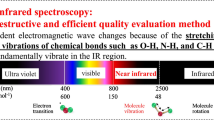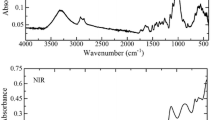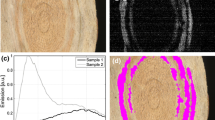Abstract
Purpose of Review
Forest and wood products are often characterized by a uniformity of quality attributes, which necessitates the development of rapid and non-destructive quality evaluation methods to ensure their optimal quality. Near-infrared spectroscopy (NIRS) represents a highly suitable approach for the characterization of organic compounds, and is generally combined with sophisticated multivariate analysis methods. This review article presents a range of scientific and technical reports showcasing the successful use of NIRS for evaluating forest and wood products, mainly published within the past 5 years.
Recent Findings
Continuous advancements in spectral imaging techniques and the integration of big-data analytics have greatly enhanced the capabilities of NIR instrumentation, enabling its widespread application across diverse fields. Although NIR spectral imaging methods do have some limitations when it comes to online grading, they can still be used to test small quantities of samples at a batch level. Moreover, the ever-increasing use of handheld devices has made NIRS easily accessible.
Summary
We aim to provide a summary of new research in basic spectroscopic research, integrating the improvements of spectral imaging methods and big-data analytics. Furthermore, low-cost and portable devices have been produced, enabling remote analysis and further expanding the scope of NIRS applications. Looking forward, we anticipate that continued advancements in this field will enable even wider applications of NIRS for online or at-line quality monitoring in diverse fields.





Similar content being viewed by others
Data Availability
Not applicable.
References
Papers of particular interest, published recently, have been highlighted as: • Of importance •• Of major importance
Tsuchikawa S, Kobori H. A review of recent application of near infrared spectroscopy to wood science and technology. J Wood Sci. Springer Japan; 2015;61:213–20. Available from: https://doi.org/10.1007/s10086-015-1467-x.
Tsuchikawa S, Ma T, Inagaki T. Application of near-infrared spectroscopy to agriculture and forestry. Anal Sci. 2022;38:635–42. Available from: https://doi.org/10.1007/s44211-022-00106-6.
Liang L, Fang G, Deng Y, Wu T, Liang L, Xiong Z, et al. Determination of moisture content and basic density of poplar wood chips under various moisture conditions by near-infrared spectroscopy. For Sci. 2019;65:548–55.
Kobori H, Gorretta N, Rabatel G, Bellon-Maurel V, Chaix G, Roger JM, et al. Applicability of Vis-NIR hyperspectral imaging for monitoring wood moisture content (MC). Holzforschung. 2013;67:307–14.
Wold S. Pattern recognition by means of disjoint principal components models. Pattern Recognit. 1976;8:127–39.
Lavine BK. Chemometrics. Anal Chem. American Chemical Society; 2000;72:91–8. Available from: https://doi.org/10.1021/a1000016x.
Roggo Y, Chalus P, Maurer L, Lema-Martinez C, Edmond A, Jent N. A review of near infrared spectroscopy and chemometrics in pharmaceutical technologies. J Pharm Biomed Anal. 2007;44:683–700.
Norris KH, Butler WL. Techniques for obtaining absorption spectra on intact biological samples. Ire Trans Biomed Electron IEEE. 1961;8:153–7.
Birkett MD, Gambino MJT. Estimation of pulp kappa number with near-infrared spectroscopy. Tappi J. 1989;72:193–7.
Ma T, Inagaki T, Tsuchikawa S. Calibration of SilviScan data of Cryptomeria japonica wood concerning density and microfibril angles with NIR hyperspectral imaging with high spatial resolution. Holzforschung. 2017;71:341–7. Available from: https://doi.org/10.1515/hf-2016-0153. This paper provides a practical example of how NIR imaging method can be used to map wood properties. The mapping results are useful to check the property differences between earlywood and latewood, as well as between normal wood and compression wood parts.
Alves A, Hevia A, Simões R, Majada J, Alia R, Rodrigues J. Improving spatial synchronization between X-ray and near-infrared spectra information to predict wood density profiles. Wood Sci Technol. Springer Berlin Heidelberg; 2020;54:1151–64. Available from: https://doi.org/10.1007/s00226-020-01207-z.
Sofianto IAD, Inagaki T, Ma T, Tsuchikawa S. Effect of knots and holes on the modulus of elasticity prediction and mapping of sugi (Cryptomeria japonica) veneer using near-infrared hyperspectral imaging (NIR-HSI). Holzforschung. 2019;73:259–68.
Schimleck L, Ma T, Inagaki T, Tsuchikawa S. Review of near infrared hyperspectral imaging applications related to wood and wood products. Appl Spectrosc Rev. 2022:1–25.
Schimleck LR, Tsuchikawa S. Application of NIR spectroscopy to wood and wood-derived products. Handb. Near-Infrared Anal. CRC Press: Boca Raton, Florida; 2021.
Ma T, Schimleck L, Dahlen J, Yoon S-C, Inagaki T, Tsuchikawa S, et al. Comparative performance of NIR-hyperspectral imaging systems. Foundations. 2022;2:523–40.
Lu Y, Saeys W, Kim M, Peng Y, Lu R. Hyperspectral imaging technology for quality and safety evaluation of horticultural products: a review and celebration of the past 20-year progress. Postharvest Biol Technol. Elsevier B.V.; 2020;170:111318. Available from: https://doi.org/10.1016/j.postharvbio.2020.111318.
Ai N, Jiang Y, Omar S, Wang J, Xia L, Ren J. Rapid measurement of cellulose, hemicellulose, and lignin content in Sargassum horneri by near-infrared spectroscopy and characteristic variables selection methods. Molecules. 2022;27(2):335.
Li Y, Altaner C. Predicting extractives content of Eucalyptus bosistoana F. Muell. Heartwood from stem cores by near infrared spectroscopy. Spectrochim Acta - Part A Mol Biomol Spectrosc. Elsevier B.V.; 2018;198:78–87. Available from: https://doi.org/10.1016/j.saa.2018.02.068.
Fahey LM, Nieuwoudt MK, Harris PJ. Using near infrared spectroscopy to predict the lignin content and monosaccharide compositions of Pinus radiata wood cell walls. Int J Biol Macromol. Elsevier B.V.; 2018;113:507–14.
Fahey LM, Nieuwoudt MK, Harris PJ. Predicting the cell-wall compositions of solid Pinus radiata (radiata pine) wood using NIR and ATR FTIR spectroscopies. Cellulose. 2019;26:7695–716. This paper highlights the NIRS coupled with PLS regression analysis is an attractive method for rapid prediction of cell wall compositions of solid wood samples.
Sugii S, Fujimoto T, Tsutsumi H, Inagaki T, Tsuchikawa S. Dynamic behavior of wood chemical components under drying process measured by near infrared spectroscopy. J Near Infrared Spectrosc. Optica Publishing Group; 2017;25:400–6. Available from: https://opg.optica.org/jnirs/abstract.cfm?URI=jnirs-25-6-400.
Tham VTH, Inagaki T, Tsuchikawa S. A novel combined application of capacitive method and near-infrared spectroscopy for predicting the density and moisture content of solid wood. Wood Sci Technol. Springer Berlin Heidelberg; 2018;52:115–29. This study demonstrated the possibility of combining NIRS with other analytical techniques that can penetrate deeper into the sample to expand applications in wood industry.
dos Santos LM, Amaral EA, Nieri EM, Costa EVS, Trugilho PF, Calegário N, et al. Estimating wood moisture by near infrared spectroscopy: testing acquisition methods and wood surfaces qualities. Wood Mater Sci Eng. Taylor & Francis; 2021;16:336–43. Available from: https://doi.org/10.1080/17480272.2020.1768143.
Ma T, Morita G, Inagaki T, Tsuchikawa S. Moisture transport dynamics in wood during drying studied by long-wave near-infrared hyperspectral imaging. Cellulose. 2022;29:133–45.
Ma T, Inagaki T, Tsuchikawa S. Rapidly visualizing the dynamic state of free, weakly, and strongly hydrogen-bonded water with lignocellulosic material during drying by near-infrared hyperspectral imaging. Cellulose. 2020;27:4857–69. This study suggests NIR-HSI can be a novel approach for visualizing the dynamic state of free and bonded water, which is desired in the wood drying industry.
Ma T, Schimleck L, Inagaki T, Tsuchikawa S. Rapid and nondestructive evaluation of hygroscopic behavior changes of thermally modified softwood and hardwood samples using near-infrared hyperspectral imaging (NIR-HSI). Holzforschung. 2021;75:345–57.
Ma T, Morita G, Inagaki T, Tsuchikawa S. Experimental study and three-dimensional modeling of moisture transport in wood by means of near-infrared hyperspectral imaging coupled with a heat and mass transfer simulation method. Holzforschung. 2022;76:699–710.
Arriel TG, Ramalho FMG, Lima RAB, de Sousa KIR, Hein PRG, Trugilho PF. Developing near infrared spectroscopic models for predicting density of Eucalyptus wood based on indirect measurement. Cerne. 2019;25:294–300.
Alves A, Hevia A, Simões R, Majada J, Alia R, Rodrigues J. Improving spatial synchronization between X-ray and near-infrared spectra information to predict wood density profiles. Wood Sci Technol Springer. 2020;54:1151–64.
Schimleck LR, Antony F, Mora C, Dahlen J. Comparison of whole-tree wood property maps based on near-infrared spectroscopic calibrations utilizing data at different spatial resolutions. Holzforschung. De Gruyter; 2020;74:20–32. This paper shows that the NIRS is a powerful method in practical field research.
Li Y, Via BK, Li Y. Lifting wavelet transform for Vis-NIR spectral data optimization to predict wood density. Spectrochim Acta - Part A Mol Biomol Spectrosc. 2020;240:118566.
Ma T, Schajer G, Inagaki T, Pirouz Z, Tsuchikawa S. Optical characteristics of Douglas fir at various densities, grain directions and thicknesses investigated by near-infrared spatially resolved spectroscopy (NIR-SRS). Holzforschung. 2018;72:789–96.
Mancini M, Leoni E, Nocetti M, Urbinati C, Duca D, Brunetti M, et al. Near infrared spectroscopy for assessing mechanical properties of Castanea sativa wood samples. J Agric Eng. 2019;50:191–7.
Yu L, Liang Y, Zhang Y, Cao J. Mechanical properties of wood materials using near-infrared spectroscopy based on correlation local embedding and partial least-squares. J For Res. Springer Berlin Heidelberg; 2020;31:1053–60. Available from: https://doi.org/10.1007/s11676-019-01031-7.
Fujimoto T. Evaluation of wood variation based on the eigenvalue distribution of near infrared spectral matrix. J Near Infrared Spectrosc. 2019;27:175–80.
Kobori H, Inagaki T, Fujimoto T, Okura T, Tsuchikawa S. Fast online NIR technique to predict MOE and moisture content of sawn lumber. Holzforschung. 2015;69:329–35. This paper shows a typical application example of using NIRS for online quality control of wood lumbers, explaining both concepts and methods with clarity.
Sofianto IA, Inagaki T, Kato K, Itoh M, Tsuchikawa S. Modulus of elasticity prediction model on sugi (Cryptomeria japonica) lumber using online near-infrared (NIR) spectroscopic system. Int Wood Prod J. 2017;8:193–200.
Ma T, Inagaki T, Yoshida M, Ichino M, Tsuchikawa S. Measuring the tensile strain of wood by visible and near-infrared spatially resolved spectroscopy. Cellulose. 2021;28:10787–801.
Chu D, Mu J, Avramidis S, Rahimi S, Lai Z, Ayanleye S. Effect of heat treatment on bonding performance of poplar via an insight into dynamic wettability and surface strength transition from outer to inner layers. Holzforschung. 2020;74:777–87.
Sandak J, Sandak A, Cocchi M. Multi-sensor data fusion and parallel factor analysis reveals kinetics of wood weathering. Talanta. 2021;225:122024.
Vidholdová Z, Sandak A, Sandak J. Assessment of the chemical change in heat treated pine wood by near infrared spectroscopy. Acta Fac Xylologiae Zvolen. 2019;61:31–42.
Devos P, Commandre JM, Brancheriau L, Candelier K, Rousset P. Modeling mass loss of biomass by NIR-spectrometry during the torrefaction process. Int J Energy Res. 2020;44:9787–97.
Inagaki T, Asanuma Y, Tsuchikawa S. Selective assessment of duplex heat-treated wood by near-infrared spectroscopy with principal component and kinetic analyses. J Wood Sci. Springer Japan; 2018;64:6–15. Available from: https://doi.org/10.1007/s10086-017-1670-z.
Nasir V, Nourian S, Zhou Z, Rahimi S, Avramidis S, Cool J. Classification and characterization of thermally modified timber using visible and near-infrared spectroscopy and artificial neural networks: a comparative study on the performance of different NDE methods and ANNs. Wood Sci Technol. Springer Berlin Heidelberg; 2019;53:1093–109. Available from: https://doi.org/10.1007/s00226-019-01120-0.
Mahdiyanti SH, Inagaki T, Tsuchikawa S. Analysis of wood thermal degradation using 2D correlation of near infrared and visible-light spectroscopy. J Near Infrared Spectrosc. 2019;27:354–69. Available from: https://doi.org/10.1177/0967033519863878.
Inagaki T, Yonenobu H, Asanuma Y, Tsuchikawa S. Determination of physical and chemical properties and degradation of archeological Japanese cypress wood from the Tohyamago area using near-infrared spectroscopy. J Wood Sci Springer Japan. 2018;64:347–55.
Liang L, Wu T, Fang G, Xu F, Jiao J, Deng Y, et al. Predicting bleachability of Eucalyptus mechanical pulp by moisture content-dependent near-infrared spectroscopy. Ind Crops Prod. 2022;180:114730.
Yang H, Liu Y, Xiong Z, Liang L. Rapid determination of holocellulose and lignin in wood by near infrared spectroscopy and kernel extreme learning machine. Anal Lett. Taylor & Francis; 2020;53:1140–54. Available from: https://doi.org/10.1080/00032719.2019.1700267.
Liang L, Wei L, Fang G, Xu F, Deng Y, Shen K, et al. Prediction of holocellulose and lignin content of pulp wood feedstock using near infrared spectroscopy and variable selection. Spectrochim Acta - Part A Mol Biomol Spectrosc. 2020;225:117515.
Lang C, Costa FRC, Camargo JLC, Durgante FM, Vicentini A. Near infrared spectroscopy facilitates rapid identification of both young and mature Amazonian tree species. PLoS ONE. 2015;10:1–16.
Mancini M, Taavitsainen VM, Toscano G. Comparison of three different classification methods performance for the determination of biofuel quality by means of NIR spectroscopy. J Chemom. 2019;33:1–11.
Zhou Z, Rahimi S, Avramidis S. On-line species identification of green hem-fir timber mix based on near infrared spectroscopy and chemometrics. Eur J Wood Wood Prod. Springer Berlin Heidelberg; 2020;78:151–60. Available from: https://doi.org/10.1007/s00107-019-01479-8.
Yang SY, Kwon O, Park Y, Chung H, Kim H, Park SY, et al. Application of neural networks for classifying softwood species using near infrared spectroscopy. J Near Infrared Spectrosc. 2020;28:298–307.
Kanayama H, Ma T, Tsuchikawa S, Inagaki T. Cognitive spectroscopy for wood species identification: near infrared hyperspectral imaging combined with convolutional neural networks. Analyst. Royal Society of Chemistry; 2019;144:6438–46. Available from: https://doi.org/10.1039/c9an01180c. This paper introduces a major spectral imaging data analysis development: apply convolutional neural networks for automatically identifying 120 hardwood samples into 38 species in a nondestructive and rapid manner.
Kobori H, Higa S, Tsuchikawa S, Kojima Y, Suzuki S. Segregating wood wastes by repetitive principal component analysis of near infrared spectra. J Near Infrared Spectrosc. SAGE Publications Sage UK: London, England; 2017;25:180–7.
Ban M, Inagaki T, Ma T, Tsuchikawa S. Effect of cellular structure on the optical properties of wood. J Near Infrared Spectrosc. 2018;26:53–60. Available from: https://doi.org/10.1177/0967033518757233.
Ma T, Inagaki T, Tsuchikawa S. Three-dimensional grain angle measurement of softwood (Hinoki cypress) using near infrared spatially and spectrally resolved imaging (NIR-SSRI). Holzforschung. 2019;73:817–26.
Ma T, Inagaki T, Ban M, Tsuchikawa S. Rapid identification of wood species by near-infrared spatially resolved spectroscopy (NIR-SRS) based on hyperspectral imaging (HSI). Holzforschung. 2019;73:323–30.
Funding
Tsuchikawa, Inagaki: Japan Society for the Promotion of Science, 25292102, 22H02405.
Ethics declarations
Ethical Approval
Not applicable.
Conflict of Interest
Not applicable.
Human and Animal Rights and Informed Consent
This article does not contain any studies with human or animal subjects performed by any of the authors.
Additional information
Publisher’s Note
Springer Nature remains neutral with regard to jurisdictional claims in published maps and institutional affiliations.
Rights and permissions
Springer Nature or its licensor (e.g. a society or other partner) holds exclusive rights to this article under a publishing agreement with the author(s) or other rightsholder(s); author self-archiving of the accepted manuscript version of this article is solely governed by the terms of such publishing agreement and applicable law.
About this article
Cite this article
Tsuchikawa, S., Inagaki, T. & Ma, T. Application of Near-Infrared Spectroscopy to Forest and Wood Products. Curr. For. Rep. 9, 401–412 (2023). https://doi.org/10.1007/s40725-023-00203-3
Accepted:
Published:
Issue Date:
DOI: https://doi.org/10.1007/s40725-023-00203-3




